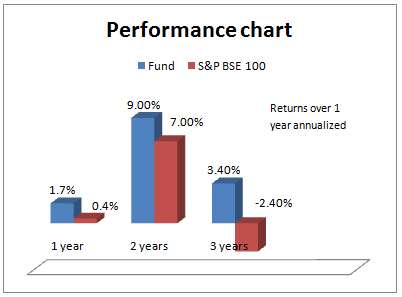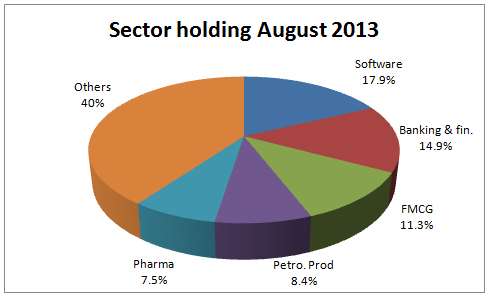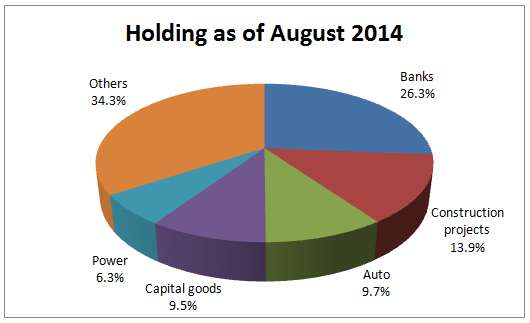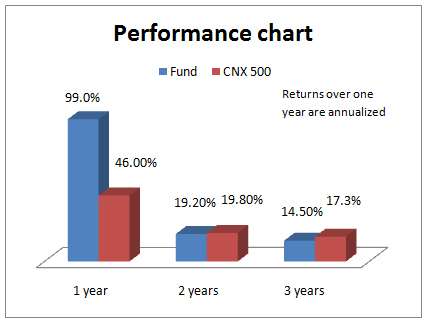Prajna Capital |
| Posted: 29 Oct 2015 04:57 AM PDT Canara Robeco Large Cap+ - Invset online
Investors looking to hold blue chip stocks in the Indian equity universe may find Canara Robeco Large Cap+ to be a conservative choice for their portfolio. With single-digit returns over 1- and 3-year periods, this fund, of course cannot boast of a splendid returns record, courtesy the poor market condition almost since the fund's inception. That said, the fund has performed in line with more established peers such as Franklin India Bluechip and ICICI Pru Focused Bluechip over 1-, 2- and 3-year periods, suggesting that it may be on course to chart itself a good track record. Investors with a long-term perspective can consider small exposure to this fund, if they already hold other established peers. Have a minimum 5-year time frame to hold the fund. Suitability Canara Robeco Large Cap+ does not have a sufficient record of experiencing a full market cycle – of bull and bear phases. However, it has proved its mettle in one of the toughest phases – volatile market conditions. Containing volatility should therefore be the key reason if you wish to hold this fund. Unlike some of the other emerging top peers such as Axis Equity, which takes some exposure to mid-cap stocks as well, Canara Robeco Large Cap+ is exposed entirely to large caps. That means its return potential may be capped in a more broad-based market rally. That said, in uncertain economic conditions such as the present one, its large-cap holding can contain downsides much better and also offer decent returns in an upturn. The present market volatility has also ensured that some of the large-cap stocks are available at attractive valuations as a result of either a broad correction, or a specific sector remaining out of favour. Seen from this perspective, this fund is more suitable for the current market conditions. Its higher exposure to tech stocks, unlike most fund portfolios that sport banking and finance sector as their top holding, is also one reason why the fund's portfolio may suit the current volatile interest rate and currency environment. Performance
That the fund is adept at containing declines came to light in 2011 when it lost 12.8% of its NAV that year; while established peers such as Franklin India Bluechip lost 18.2%. Slightly more diversified and flashy peers such as Axis Equity lost as much as 22.6%. But in rallying markets such as 2012, the fund's return was capped at 28.2% even as peers managed 3-4 percentage points more. Overall, on a rolling 1-year return basis, the fund beat its benchmark 83% of the times. This record could go down in extended rallies as a pure large-cap fund like Canara Robeco Large Cap+ may not find it easy to beat a slightly broader benchmark like BSE 100. The Nifty appears to be a better benchmark for this fund, given its current strategy. Portfolio Canara Robeco Large Cap+ had a compact portfolio of 36 stocks as of August 2013. Despite its large-cap nature, the fund has been rejigging its portfolio continuously, either tweaking individual stock holdings or occasionally shedding stocks. FMCG stocks such as Nestle India and ITC were all pruned by May, although the fund continued to hold them.
Unlike most fund portfolios that hold maximum exposure to the banking and finance space, the fund has provided top weight to the IT space. While the fund too held over 20% exposure to the banking and finance space at the beginning of the year, it significantly pruned exposure soon as the troubles of the banking space came to light. Among other stocks, Power Grid Corporation of India and Oil India appear to be stocks that may have been picked for their 'value' at depressed price levels. It is noteworthy that Canara Robeco Equity Diversified, a sister fund also has a large-cap bias but has select mid-cap holdings, as against the strict large-cap holding in Canara Robeco Large Cap+. The fund does not also shy away from holding cash even up to 15% when market conditions warrant. This is perhaps one reason why it contains declines better than peers. The fund is managed by Ravi Gopalakrishnan. Best Tax Saver Mutual Funds or ELSS Mutual Funds for 2015
1.ICICI Prudential Tax Plan 2.Reliance Tax Saver (ELSS) Fund 3.HDFC TaxSaver 4.DSP BlackRock Tax Saver Fund 5.Religare Tax Plan 6.Franklin India TaxShield 7.Canara Robeco Equity Tax Saver 8.IDFC Tax Advantage (ELSS) Fund 9.Axis Tax Saver Fund 10.BNP Paribas Long Term Equity Fund
You can invest Rs 1,50,000 and Save Tax under Section 80C by investing in Mutual Funds
Invest in Tax Saver Mutual Funds Online - For further information contact Prajna Capital on 94 8300 8300 by leaving a missed call --------------------------------------------- Leave your comment with mail ID and we will answer them OR You can write to us at PrajnaCapital [at] Gmail [dot] Com OR Leave a missed Call on 94 8300 8300 --------------------------------------------- Invest Mutual Funds Online Download Mutual Fund Application Forms from all AMCs |
| Posted: 29 Oct 2015 04:32 AM PDT HDFC Infrastructure Fund - Invest Online For those of you who saw the meteoric rise in the price of stocks from the engineering and infrastructure space, the temptation to own a fund that offers this theme may have been high. This temptation would increase manifold if you see an infrastructure fund delivering a whopping 99% in the past 1 year, outperforming its benchmark CNX 500's return of 44% and also dwarfing the CNX Infrastructure Index' performance of 41.5% in the same period. The fund with the above returns is HDFC Infrastructure Fund. But should you enter the fund when returns and valuations of stocks in this space have already run up? Also, should you even hold such themes, especially given the prolonged pain this space can undergo, if 2008-13 was any evidence to that? Read on. The Themes Infrastructure funds typically hold stocks from the financial space, engineering companies, construction and power companies, and even automobiles to name a few. So what exactly encompasses 'infrastructure?' Broadly, three themes and their allied themes – asset financiers, asset creators and asset owners/developers.
Asset financiers – Banks and infrastructure finance companies that provide debt for long-term infrastructure projects come under this category. This segment, although run up quite a bit, still has pockets of value either because of the broad concern about asset quality, or as a result of slowing credit growth in the economy. Either way, their valuations provide opportunities for those willing to wait out for the long haul. You will find that stocks such as SBI, that HDFC Infrastructure held for long (although reduced in the last 1 year, with the stock delivering well), was part of such a strategy to pick at reasonably low valuations and hold. Asset creators – These broadly fall under two categories. One segment would be contracting companies that take up project executions for a price. These could be builders of infrastructure projects, factories, or properties, or those who execute projects for power companies, or for any manufacturing company (steel, cement) and so on. The other category is capital goods and engineering companies that manufacture equipments/goods that are used in any infrastructure project. Sometimes, these could go one step and also execute the projects (Engineering, Procurement and Construction companies). For instance, Larsen & Toubro, Crompton Greaves, Bharat Electronics, to name a few are some of the stocks in HDFC Infrastructure Fund's portfolio that fit this category. Now, typically this is a large universe as it encompasses a range of companies across engineering, capital goods and even those that provide support services such as logistics and so on. Asset owners/developers: These would be companies that own assets – for instance, companies that hold coal blocks or other mines, power generation companies, port/airport developers, or those that hold and operate roads and hold them as assets in their books. This segment is not very large in number but considered risky in the Indian scenario as most of them are highly leveraged companies, and can go through very painful periods of slowdown in their revenue and their struggle to service their debt. The Opportunity In the three broad categories mentioned above, banks/financial companies still offer pockets of value, and this sector would receive the highest weight in most infrastructure funds as they have the highest weights in all key indices. The second category, i.e., asset creators are split in terms of their potential, risk and return features. For instance, there are a number of companies in the space that are low on debt and have a high operating leverage – that is, they generate high earnings growth with a small pick up in revenue. This is the segment that offers returns most often and as seen in HDFC Infrastructure's portfolio, is also subject to churn if they deliver returns too quickly. This segment can be expected to continue to deliver returns as they are available across market-cap segments, and across industries, and come leveraged or with nil leverage (depending on the business they are in). For instance, stocks such as Sadbhav Engineering or Blue Star, which were seen in the fund's portfolio a year ago, were either pruned or moved out after delivering high returns, and others such as Larsen & Toubro or KEC International were bumped up. The third segment – asset owners – is where more short-term returns came by, but risks still remain. Clearly,HDFC Infrastructure too saw these risks, but not without taking some gains off the table. Stocks such as GVK Power and Infrastructure, Coal India or Sesa Goa all exited the fund a while ago. Long story short, cyclical sectors tend to move ahead of valuations in anticipation of an earnings recovery, which usually adequately makes up for the rally. However, in the current scenario, the recovery appears painful in some spaces (asset owners for example) and quite on track in others (pockets of asset creators). Hence, while it would be fair to assume that the extraordinary rally period may be over; it provides us comfort in terms of moving away from mere trading opportunities to looking at valuation/recovery stories to ride the space over a 3-5 year period. Suitability Two lessons from the above discussion: one, the fund is not for those looking for extraordinary returns from here on. Two, with a recovery story in place, the fund could well beat diversified funds over a 3-year time frame; but then, during periods of volatility, you should be ready to be shaken by falls but not get too shaken. Three, the fund certainly cannot form the core of your portfolio and must account for not more than 10% of your portfolio. Performance
Still, the fund only sports a 3-year return of 14.5% compounded annually – lower than 17.3% return of its benchmark CNX 500. But a 3-year SIP in the fund would have yielded a much higher IRR of 29.3% (23% by CNX 500), suggesting that its volatility worked well when it came to averaging using SIPs. The fund held Rs. 1,690 crore of assets as of August 2014. It is managed by Prashant Jain and Srinivas Rao Ravuri. Best Tax Saver Mutual Funds or ELSS Mutual Funds for 2015
1.ICICI Prudential Tax Plan 2.Reliance Tax Saver (ELSS) Fund 3.HDFC TaxSaver 4.DSP BlackRock Tax Saver Fund 5.Religare Tax Plan 6.Franklin India TaxShield 7.Canara Robeco Equity Tax Saver 8.IDFC Tax Advantage (ELSS) Fund 9.Axis Tax Saver Fund 10.BNP Paribas Long Term Equity Fund
You can invest Rs 1,50,000 and Save Tax under Section 80C by investing in Mutual Funds
Invest in Tax Saver Mutual Funds Online - For further information contact Prajna Capital on 94 8300 8300 by leaving a missed call --------------------------------------------- Leave your comment with mail ID and we will answer them OR You can write to us at PrajnaCapital [at] Gmail [dot] Com OR Leave a missed Call on 94 8300 8300 --------------------------------------------- Invest Mutual Funds Online Download Mutual Fund Application Forms from all AMCs |
| Mutual Funds SIPs - Anytime a Good Time to Invest Posted: 29 Oct 2015 03:26 AM PDT Mutual Funds SIPs - Invest Online With equity markets zooming from September 2013 until now, you may either be feeling left out, or you may fear entering the market rather late. You don't have to, if you decide to go the Systematic Investment Plan (SIP) way. Why? Because SIPs are the best all-weather tools you can have to invest, especially in equities. 'Do SIPs always offer the best returns? – this may be a question that many of you may have asked yourself or your advisor. The answer is 'NO'. But what SIPs do is insulate your best against worst returns. It is because of this insulation that you earn optimal, and very often superior, returns against the lump sum investing method. In other words, SIPs build wealth by shielding your portfolio from market extremes. They offer the best downside protection by simply averaging at lower costs and lowering your overall investment cost. That said, many of you may have had a very forgettable experience with equity funds and therefore, you may have shut the door to this clear wealth building asset class. Knowing when you can get hurt will help you do away with this fear. When You Can Get Hurt Broadly, there are a few reasons on why you may have burnt your fingers in the equity mutual fund market. They are: Points 1 and 2 are not difficult to tackle. On point 1, if your fund has been underperforming its benchmark for over 4 quarters, then you should not have stuck to it. Else, the best you can do is ask your advisor to review your portfolio annually. On point 2, you must remember that equities are for the long haul. If you had a very short time frame, equity funds are not the place to be. So, the real problem comes from the other two points; and all they require you to do is keep it simple, and to keep it going with SIPs. Lump Sum Vs. SIPs If you had invested in the market peak of January 2008, losing about 55% of your capital by the end of that year is a classic example of the near-term impact of lump sum investing. But had you held on and been a good long-term investor, the market would not have disappointed you. Better still, had you been doing an SIP, the equity market would have rewarded you more. Take a look at some of the steady performing funds from our 'Select Funds' list to know how SIPs reward you for patiently continuing your investments. The table below shows the returns from lump sum investments made in mid-2007 (July 2007), when the markets were trending upwards, and the return on SIPs made from then on till date.
SIPs worked better. Why? Because of the opportunity to average costs at lower levels in 2009, 2011 and partly in 2013. Lesson: Long-term investing is a must for equities. Even for the long term, while lump sums are ok, SIPs work harder for you. Stopping SIPs Investors often stop their SIPs even with good funds for two reasons: Let us take a more recent 3-year period to know what happens when you stop SIPs but hold your funds. Had you started SIPs in 2011 and continued for 1 year, and then you stopped your SIPs thinking that the market was going up, your returns would have been 7-8 percentage points lower than continuing SIPs till date.
Why? 2013 offered enough opportunities to average costs at lower levels. And with markets going up now, the average returns tend to be higher with the SIPs you continued. Lesson: If you started your SIP for a specific long-term goal, keep the SIP running until your near the goal. Stopping either because the market has gone up or gone down, not only disrupts returns but prevents you from saving the necessary amount for the goal. The Bounce Back Above all these, the bounce back in the market is felt immediately in SIP portfolios. Just take a look at the data below. Not only have the SIP returns between March and now bounced back, the returns are also far superior to lump sum investing as a result of better averaging.
The lesson: The effect of all your averaging is felt in your portfolio in a market revival and quite fast too. Hence, the key is to keep it to SIPs and keep it going if you want to ride the equity market bulls and bears. Best Tax Saver Mutual Funds or ELSS Mutual Funds for 2015
1.ICICI Prudential Tax Plan 2.Reliance Tax Saver (ELSS) Fund 3.HDFC TaxSaver 4.DSP BlackRock Tax Saver Fund 5.Religare Tax Plan 6.Franklin India TaxShield 7.Canara Robeco Equity Tax Saver 8.IDFC Tax Advantage (ELSS) Fund 9.Axis Tax Saver Fund 10.BNP Paribas Long Term Equity Fund
You can invest Rs 1,50,000 and Save Tax under Section 80C by investing in Mutual Funds
Invest in Tax Saver Mutual Funds Online - For further information contact Prajna Capital on 94 8300 8300 by leaving a missed call --------------------------------------------- Leave your comment with mail ID and we will answer them OR You can write to us at PrajnaCapital [at] Gmail [dot] Com OR Leave a missed Call on 94 8300 8300 --------------------------------------------- Invest Mutual Funds Online Download Mutual Fund Application Forms from all AMCs |
| You are subscribed to email updates from Prajna Capital - An Investment Guide. To stop receiving these emails, you may unsubscribe now. | Email delivery powered by Google |
| Google Inc., 1600 Amphitheatre Parkway, Mountain View, CA 94043, United States | |
 Canara Robeco Large Cap+
Canara Robeco Large Cap+

 With that above caveat in place,
With that above caveat in place,


No comments:
Post a Comment